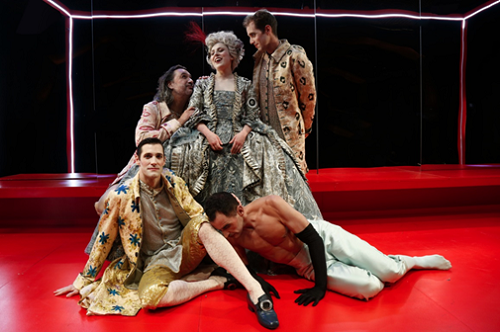 Spain García, I tre gobbi: Rubén Fernández de Aguirre (musical director & piano). Fundación Juan March, Madrid, 26.9.2021. (JMI)
Spain García, I tre gobbi: Rubén Fernández de Aguirre (musical director & piano). Fundación Juan March, Madrid, 26.9.2021. (JMI)

Production:
Director – José Luis Arellano
Set – Pablo Menor Palomo
Costumes – Ikerne Giménez
Lighting – David Picazo
Cast:
Madama Vezzosa – Cristina Toledo
Count Bellavita – David Alegret
Baron Macacco – David Oller
Marquis Parpagnacco – Javier Povedano
Servant, dancer – Andoni Larrabeiti
In his day, Manuel García (1775–1832) was a phenomenon in the world of music. A popular tenor, he premiered Rossini’s Il barbiere di Siviglia – a true star of those years. Yet he may be better known in the history of opera as the father and teacher of two great singers, María Malibrán and Pauline Viardot.
His musical activity does not end there. He was also a composer who created five operas during his life in Paris, all of them chamber music with piano accompaniment. They were performed in salons, and his well-known daughters participated.
I tre gobbi (The Three Hunchbacks) is one of those salon operas that came from his pen. It’s an authentic buffo opera, based on a story by Carlo Goldoni, and seen here in a co-production from Teatro de la Zarzuela and Fundación Juan March which have offered three other García operas in the past.
This one deals with the affairs of Madama Vezzosa. She receives visits from her lovers who have in common the fact that they are noble, rich and . . . hunchbacked. The suitors, who bear the amusing names of Marquis Parpagnacco, Baron Macacco and Count Bellavita, bring her gifts that she must hide so they are not discovered by the others. She manages to do so and to keep the suitors from one another until finally they all meet and end up proposing to love the beautiful Vezzosa as a group. She accepts the idea gladly.
The score contains arias, duets and concertantes that are pleasant to listen to, but the music has no major significance. The musical direction was under Rubén Fernández de Aguirre at the piano, and he handled the work wonderfully, playing lightly and with excellent taste. At the intermission, he had the good idea of offering a tribute to Antón García Abril, and played an outstanding interpretation of one of Abril’s interludes.
The director, José Luis Arellano, presented a lively work on a reduced stage, with Madama Vezzosa’s living room in red tones and a large mirror in the background. The period costumes are suited to the plot and the epoch.
All of the cast gave fine performances. Vocally, the best singing came from soprano Cristina Toledo as Madama Vezzosa and tenor David Alegret as Count Bellavita. The cast was completed by the entertaining Baron Macacco (baritone David Oller) and Marquis Parpagnacco (baritone Javier Povedano). And there is a mute character too – Andoni Larrabeiti as the servant.
José M. Irurzun